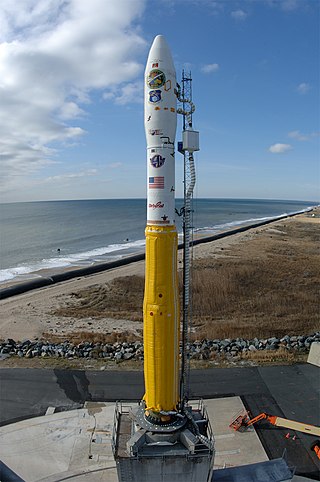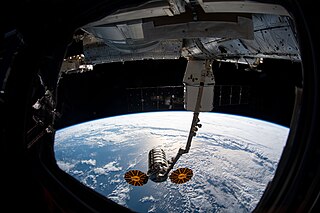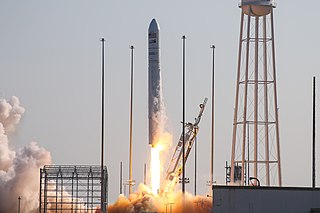
The Delta rocket family was a versatile range of American rocket-powered expendable launch systems that provided space launch capability in the United States from 1960 to 2024. Japan also launched license-built derivatives from 1975 to 1992. More than 300 Delta rockets were launched with a 95% success rate. The series was phased out in favor of the Vulcan Centaur, with the Delta IV Heavy rocket's last launch occurring on April 9, 2024.

Alliant Techsystems Inc. (ATK) was an American aerospace and arms manufacturer headquartered in Arlington County, Virginia. The company operated across 22 states, Puerto Rico, and internationally. ATK revenue in fiscal year 2014 was about US$4.8 billion.

Pegasus is an air-launched multistage rocket developed by Orbital Sciences Corporation (OSC) and later built and launched by Northrop Grumman. Pegasus is the world's first privately developed orbital launch vehicle. Capable of carrying small payloads of up to 443 kg (977 lb) into low Earth orbit, Pegasus first flew in 1990 and remained active as of 2021. The vehicle consists of three solid propellant stages and an optional monopropellant fourth stage. Pegasus is released from its carrier aircraft at approximately 12,000 m (39,000 ft) using a first stage wing and a tail to provide lift and altitude control while in the atmosphere. The first stage does not have a thrust vector control (TVC) system.
Orbital Sciences Corporation was an American company specializing in the design, manufacture, and launch of small- and medium- class space and launch vehicle systems for commercial, military and other government customers. In 2014, Orbital merged with Alliant Techsystems (ATK) to create a new company called Orbital ATK, which in turn was purchased by Northrop Grumman in 2018.
Thiokol was an American corporation concerned initially with rubber and related chemicals, and later with rocket and missile propulsion systems. Its name is a portmanteau of the Greek words for sulfur and glue, an allusion to the company's initial product, Thiokol polymer.

Minotaur-C, formerly known as Taurus or Taurus XL, is a four stage solid fueled launch vehicle built in the United States by Orbital Sciences and launched from SLC-576E at California's Vandenberg Air Force Base. It is based on the air-launched Pegasus rocket from the same manufacturer, utilizing a "zeroth stage" in place of an airplane. The Minotaur-C is able to carry a maximum payload of around 1458 kg into a low Earth orbit (LEO).

The Graphite-Epoxy Motor (GEM) is a family of solid rocket boosters developed in the late 1980s and used since 1990. GEM motors are manufactured with carbon-fibre-reinforced polymer casings and a fuel consisting of HTPB-bound ammonium perchlorate composite propellant. GEM is produced by Northrop Grumman Space Systems. GEM boosters are used on the Atlas V and were previously used on the Delta II, Delta III, and Delta IV launch vehicles. A new variant, the GEM 63XL, flew as part of the Vulcan Centaur launch vehicle on 8 January 2024.

The Minotaur is a family of United States solid fuel launch vehicles derived from converted Minuteman and Peacekeeper intercontinental ballistic missiles (ICBM). They are built by Northrop Grumman via contract with the Space Force's Space Systems Command as part of the Space Force's Rocket Systems Launch Program (RSLP) which converts retired Intercontinental Ballistic Missiles into space and test launch systems for U.S. government agencies.

The Minotaur I, or just Minotaur is an American expendable launch system derived from the Minuteman II missile. It is used to launch small satellites for the US Government, and is a member of the Minotaur family of rockets produced by Orbital Sciences Corporation.

Castor is a family of solid-fuel rocket stages and boosters built by Thiokol and used on a variety of launch vehicles. They were initially developed as the second-stage motor of the Scout rocket. The design was based on the MGM-29 Sergeant, a surface-to-surface missile developed for the United States Army at the Jet Propulsion Laboratory.

Antares, known during early development as Taurus II, is an expendable launch system developed by Orbital Sciences Corporation and the Pivdenne Design Bureau to launch the Cygnus spacecraft to the International Space Station as part of NASA's COTS and CRS programs. Able to launch payloads heavier than 8,000 kg (18,000 lb) into low Earth orbit, Antares is the largest rocket operated by Northrop Grumman. Antares launches from the Mid-Atlantic Regional Spaceport and made its inaugural flight on April 21, 2013. Antares 100 was retired in 2014 and series 200 was retired in 2023 due to component unavailability. As of January 2024 Antares 300 is under development.

Cygnus is an expendable American cargo spacecraft used for International Space Station (ISS) logistics missions. Cygnus was developed by Orbital Sciences Corporation, partially funded by NASA under the agency's Commercial Orbital Transportation Services (COTS) program. To create Cygnus, Orbital paired the Multi-Purpose Logistics Module, built by Thales Alenia Space and previously used by the Space Shuttle for ISS logistics, with a service module based on Orbital's GEOStar, a satellite bus. After a successful demonstration flight in 2013, Orbital was chosen to receive a Commercial Resupply Services (CRS) contract. A larger Enhanced Cygnus was introduced in 2015. Orbital Sciences was renamed Orbital ATK in 2015 and Northrop Grumman purchased Orbital in 2018 and has continued to operate Cygnus missions.

Commercial Resupply Services (CRS) are a series of flights awarded by NASA for the delivery of cargo and supplies to the International Space Station (ISS) on commercially operated spacecraft. The first CRS contracts were signed in 2008 and awarded $1.6 billion to SpaceX for twelve cargo Dragon and $1.9 billion to Orbital Sciences for eight Cygnus flights, covering deliveries to 2016. The Falcon 9 and Antares rockets were also developed under the CRS program to deliver cargo spacecraft to the ISS.

Launch Pad 0 (LP-0), also known as Launch Complex 0 (LC-0), or Launch Area 0 (LA-0), is a launch complex at the Mid-Atlantic Regional Spaceport (MARS) on Wallops Island, Virginia, in the United States. MARS is located right next to the NASA Wallops Flight Facility (WFF), which had run the launch complex until 2003. WFF still provides support services to MARS launches under a contract with the Commonwealth of Virginia.

NG-10, previously known as OA-10E, is the eleventh flight of the Northrop Grumman uncrewed resupply spacecraft Cygnus and its tenth flight to the International Space Station under the Commercial Resupply Services (CRS-1) contract with NASA. The mission launched on 17 November 2018, at 09:01:31 UTC. This particular mission is part of an extension of the initial CRS contract that enables NASA to cover the ISS resupply needs until the Commercial Resupply Services-2 (CRS-2) contract enters in effect.

NG-11, previously known as OA-11, is the twelfth flight of the Northrop Grumman robotic resupply spacecraft Cygnus and its eleventh flight to the International Space Station under the Commercial Resupply Services (CRS-1) contract with NASA. The mission launched on 17 April 2019 at 20:46:07 UTC. This is the last mission from the extended CRS-1 contract; follow-up missions are part of the CRS-2 contract. Cygnus NG-11 was also the first mission to load critical hardware onto Cygnus within the last 24 hours prior to launch, a new Antares feature.

OmegA was a medium-lift to heavy-lift launch vehicle concept that spent several years in development by Northrop Grumman during 2016–2020, with that development substantially funded by the U.S. government. OmegA was intended for launching U.S. national security satellites, as part of the U.S. Department of the Air Force National Security Space Launch (NSSL) replacement program.

NG-16, previously known as OA-16, was the sixteenth flight of the Northrop Grumman robotic resupply spacecraft Cygnus and its fifteenth flight to the International Space Station (ISS) under the Commercial Resupply Services (CRS-2) contract with NASA. The mission was launched on 10 August 2021 at 22:01:05 UTC, for a (planned) 90-day mission at the ISS. This was the fifth launch of Cygnus under the CRS-2 contract.

NG-18 was the eighteenth flight of the Northrop Grumman robotic resupply spacecraft Cygnus and its seventeenth flight to the International Space Station (ISS) under the Commercial Resupply Services (CRS-2) contract with NASA. The mission successfully launched on 7 November 2022 at 10:32:42 UTC. This was the seventh launch of Cygnus under the CRS-2 contract.




















